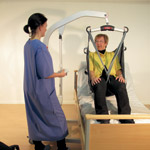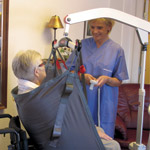
Safe-handling practices in nursing facilities and other long term care settings not only reduce injury-related costs, but also serve to improve the safety of staff and residents.
Previously referred to as no-manual-lift, the concept of using lifting devices that help direct-care staff safely move and transfer residents has evolved into a more comprehensive approach now known as a safe-handling program.
Although long term care facilities have had access to mechanical lifts for a number of years, the technology has often been viewed as too cumbersome and impractical for everyday use.
But in facilities where no-manual-lift policies have been initiated over the years, the impact on both the quality of patient care and the safety of health care workers has been significant.
Safe-handling programs take this policy a step further by encompassing education and training of all employees and ongoing mentoring of caregivers.
Staff Buy-In Vital
Implementing a safe-handling initiative at a long term care facility requires enthusiastic cooperation from nurses and nurse assistants. It is also vitally important to reduce potential barriers that may cause resistance to the program among staff members.
Some of the most common concerns voiced by nursing facility employees prior to implementation of a safe-handling program are that adequate lifting equipment is not available, the devices take too much time to use, residents refuse to use them, they don’t stay charged, they don’t always work, and the equipment is unsafe.
The doubts stated above are critical challenges that must be resolved to ensure staff compliance with the change.
Implementation and maintenance of a successful program first requires a commitment from all staff, and it must begin with the top managers.
Some providers have utilized a train-the-trainer approach to implementing a program. Empowering direct-care staff to train colleagues can be an effective motivator, especially when there are staff members who express a willingness to be trained and work with others.
Not Just Lifts
Of course, a safe-handling program requires handling devices. Although mechanical lift manufacturers continue to provide a wide spectrum of total and sit-to-stand lifts in varying weight capacities, there have been some developments during the past decade with handling device options.
To address the challenging needs of repositioning residents in the bed, friction-reducing aids are being incorporated. Some facilities are using transfer/repositioning sheets that can stay on the bed and are readily available.
Nonmotorized stand aids are used to help residents to a standing position or to assist them in toileting. Overhead ceiling lifts are also a new development in long term care, although they are a more expensive option.
The benefits of having the equipment within reach of the task creates the most efficient and convenient option available. Nursing facilities should use handling devices that are easy to move, fit under low beds, straddle mattresses on the floor, lift high enough for whirlpools, have a wheelbase that fits standard bathroom doors, and have the capacity to pick residents up off the floor.
There are two types of mechanical lift devices used with an effective safe-handling program: total lift and stand lift.
The total lift device is used to transfer patients who are unable to assist in any way, while stand lift equipment is for those who can bear weight on at least one leg but who require a stand-pivot transfer. Any resident who can stand and ambulate is not considered a lift candidate.
The sling, which attaches to the frame of a mechanical lift device, supports the weight of the resident during a lift-transfer. To accommodate a variety of individuals affected by age and disease, an adequate number and variation of sling styles are needed. Bilateral amputees, for example, require their own slings, while residents who weigh in excess of 250 pounds will require specialized slings.

Mentoring Makes A Difference
Caregiver compliance with the use of safe-handling practices is directly equal to caregiver competence. That said, the effective implementation of a safe-handling program is 10 percent design, 10 percent training, and 80 percent mentoring.
Over the years, nurse trainers have come to the realization that training someone to use the equipment is not enough—mentoring and modeling appropriate use of the equipment and handling residents is a necessary element in competency.
Many caregivers readily state that they leave a training session feeling confident in the use of the equipment; however, when faced with the realities of small resident rooms and residents who are contracted or combative, they realize there is more to the use of the device than just the operation.
Expert-level nurses should mentor the proper use of equipment with actual residents who present unique challenges not covered in training.
By modeling lifts, transfers, and repositions with residents who have different needs, the nurse trainer can support the caregiver learning process with the demonstration and reinforcement of best practices. Many caregivers say that once they have participated in this type of learning, their competency in using the equipment is boosted.
Broad-Scale Education
Implementing and maintaining a safe-handling program involves almost every department in a facility. For example, the laundry department must be aware of the special handling of the slings.
Cloth slings should be laundered at a temperature that meets infection control guidelines but does not include the use of bleach in the wash cycle. Training these employees in a way that illustrates how important their role is helps improve their appreciation of the importance of following the guidelines. In addition, a sling that shows signs of wear should be removed from service.
Maintenance personnel must be trained to inspect the lifts and ensure their functionality on a consistent basis.
The housekeeping department should be responsible for scheduling regular cleaning of the equipment, while admissions must notify new residents about the safe-handling policies and procedures.
Training new hires and all caregivers annually on safe-handling practices is also crucial in maintaining the effectiveness of a program. New-hire training should include both didactic and hands-on equipment training. New caregivers’ skills should be observed and mentored to validate competency.
All responsible departments should receive training on their roles and responsibilities initially and annually.
After redesigning and creating all the necessary support processes and educating staff, patients, and patients’ representatives on the mechanics of the equipment, a facility can begin the process of initiating the safe-handling program.
Inform Residents, Families
It is important for caregivers to realize that progress may be slow going at first, until they become proficient at using the mechanical-lift devices.
More than 10,000 nurse assistants in the United States have been asked how long it takes to become time efficient with this equipment, and the answers vary from “the first time I used it” to “six months.” Changing work processes involves time. Also important to remember is that all documentation, care processes, and enforcement of the relevant policies and procedures must be integrated within regulatory guidelines.
A critical example is residents’ rights. Prior to implementation of a safe-handling program, the policies and procedures involved must be presented in writing to resident representatives and to residents themselves.
Patients must be given ample time to discuss what the program provides and have an opportunity to view a demonstration of the function of the lifts.
Educating residents is a key factor in reducing their resistance to mechanical lifts.
Monitor Compliance
To reinforce and support lift use, training needs and support processes must be monitored on an ongoing basis.
Monitoring requires an ongoing evaluation of equipment function and sling and accessory availability. All slings should be inspected for tears or signs of wear and removed from service if found.
Caregivers, for example, must determine logistics for training direct-care staff on specialty slings, creating processes for difficult patients, assessing sling availability, gauging battery change schedules, and orienting new hires.
Implementing and maintaining a successful program is possible, if not easy. The cost savings and the impact on quality of care reflect the benefits. There may soon be a day when all nursing facilities will no longer permit employees to manually lift or transfer patients.
And although the awareness of the need for safe handling has increased dramatically in the past decade, there remains a lack of financial incentives for providers. With the increasing focus on new health care worker protection legislation, there is hope that some remedies will be offered.
Click
HERE for a list that describes the benefits of a safe resident-handling program.
Betty Z. Bogue, RN, BSN, is president of Prevent, Hickory, N.C. (www.getalift.com). She can be reached at (828) 261-0043.